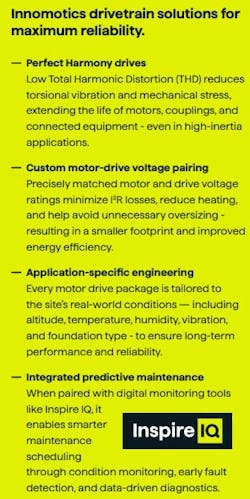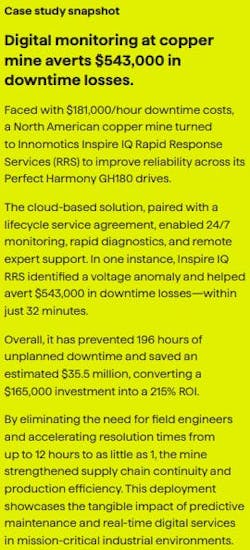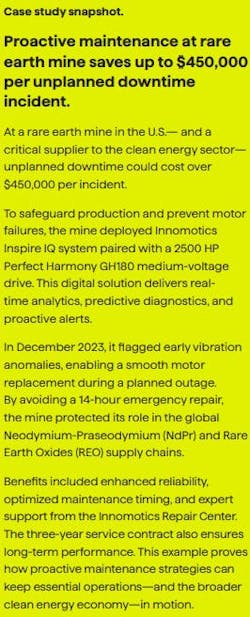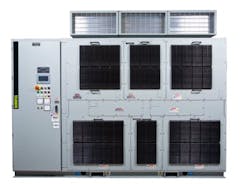Achieving maximum reliability with drive systems
Abstract.
Industrial operations rely on highly efficient and reliable drivetrain systems to maximize availability while reducingoperational disruptions and costs. However, mismatched or improperly specified motor-drive pairings often leadto unplanned downtime, excessive maintenance costs, and performance inefficiencies. This white paper explores how using a holistic, application-driven approach can help minimize drivetrain failures, reduce Total Harmonic Distortion (THD), enable predictive maintenance, and deliver long-term cost savings via lower total cost of ownership (TCO). It explains how an integrated approach to drive system design ensures maximum efficiency, reliability, andperformance.
Introduction: The case for drive systems.
In heavy industrial environments—from cement kilns to steel mills, mineral processing plants, and across many other sectors—an electric drive train is at the heart of production. Its reliability directly determines throughput, costefficiency, and production uptime. Yet, all too often, that reliability is undermined by a simple but costly issue: a motor and drive that aren’t truly engineered to work together under the actual service conditions they’ll face.
When a drive is selected from one vendor, a motor from another, and accessories from a catalog, the resulting system may work on paper—but in the field, the risks quickly surface. Examples can include thermal mismatches, harmonic distortions, shaft currents, and vibration sensitivities. Unexpected breakdowns can also be triggered by humidity, dust, altitude, or misalignment.
These cases aren’t outliers; they can be routine in 24/7 production operations, especially in rugged environments. They carry steep consequences in unplanned downtime, shortened component life, and inflated maintenance costs. Using a holistic engineering methodology that pairs motors and drives with surgical precision can help match load profiles, voltage conditions, and environmental realities to deliver optimal performance, lower lifecycle costs, and uncompromised reliability.
Reliability challenges in mismatched drive systems.
A common threat to drive system reliability is mismatched component selection. When motors and drives are sourced independently, even well-intentioned design engineers can fall into the trap of stacking safety margins—oversizing one component to compensate for unknowns in the other. The possible results: inefficiencies, added cost, and thermal or electrical stresses that were never anticipated in the original specification.
Voltage mismatches are another reliability threat. If a drive’s output doesn’t precisely align with its motor’s input requirements, the system may draw excessive current, increasing I²R heating losses, reducing energy efficiency, and accelerating wear. Over time, this seemingly minor issue can cascade into bearing degradation, insulation failure, and derated motor operations.
The cost of unplanned downtime due to drivetrain failures.
Unplanned failures in drivetrains are rarely isolated. Bearing failures, shaft current events, or torsional vibrations can take down not just a motor, but an entire production line. Such outages often can trigger huge costs in lost productivity—not to mention the secondary costs of emergency repairs, replacement parts, and restarting complex processes. They can also jeopardize customer delivery commitments.
Performance optimization and cost reduction.
To address these challenges, drivetrain solutions like those offered by Innomotics are engineered as unified wholes, precisely matching not only power and torque requirements but also accounting for environmental stresses, installation layout, coupling dynamics, and voltage optimization. By using a complete drivetrain solution, the drive delivers precisely the voltage the motor is designed to handle—no overdesign, no underperformance. It also enables derating factors to be factored in for altitude, temperature, and overload profiles during the design phase, rather than addressing them reactively in the field.
By getting the specification right up front—and building in reliability at every layer—these solutions minimize failure risks, extend component lifecycles, and deliver the exact performance specified, day in and day out.
Enhancing reliability & performance.
Reliability doesn’t come from component quality alone—it comes from system-level design thinking. That’s the core advantage of carefully designed drive system solutions, achieved by engineering the motor, drive, and accessories to function together under the customer’s specific application requirements and operational conditions.
Application-specific design for real-world service conditions.
Many drivetrain failures occur not because the equipment was faulty, but because it was specified for a “usual” service condition that didn’t match a facility’s actual environment, which might involve high ambient heat, elevated altitudes, dust infiltration, side loading, or insufficient foundations. For example, in regions where temperature swings can affect shaft alignment, Innomotics may recommend a flexible coupling rather than a rigid one to absorb thermal expansion without transmitting damaging stresses to the bearings. Where moisture or dust ingress are concerns, sealed or specially vented enclosures are used to prevent tracking and insulation breakdown. These are precisely the risks that get overlooked in generic, catalog-based system pairings.
Reducing failures caused by torsional vibration.
Total Harmonic Distortion (THD) isn’t just a nuisance; it’s a mechanical reliability threat. THD in voltage or current generates cyclic torque, creating torsional oscillations across the drivetrain. Left unmanaged, these oscillations can stress couplings, loosen mounts, and even crack shafts over time. Designing a motor drive package with low THD levels is crucial to reducing torsional vibration, which protects the drivetrain’s overall mechanical integrity.
Ensuring optimal motor-drive voltage pairing.
Optimizing the voltage for the overall system is yet another important factor in choosing the suitable motor drive package. Poorly matched voltages can lead to overdesign, increased energy losses, and the need for unnecessarily large and expensive components. Worse, if derating factors aren’t accounted for—such as altitude or overload conditions—the motor may operate outside of its thermal envelope, reducing reliability and lifespan. This is solved through precise voltage matching that balances electrical and thermal efficiency, minimizes I²R losses, and avoids overspending on oversized equipment. Tuning the voltage at both ends of the system ensures the motor receives exactly what it needs—no more, no less.
Precision engineering for site-specific reliability.
Whether specifying couplings to accommodate shaft dynamics, selecting motor frame materials to resist corrosion, or designing enclosures to prevent moisture and dust ingress, engineers take a holistic approach to ensuring drivetrain longevity. This includes auxiliary components like grounding systems, filters, and even cabling—each chosen or configured to perform under the exact service conditions the system will face. By addressing application and environmental realities from the start, drive system providers like Innomotics remove the need for field-level workarounds, aftermarket retrofits, or unplanned redesigns. The result: a quieter, more stable, and significantly more reliable drive system—purpose-built for the job it’s commissioned for.
The business case: Cost, efficiency & competitive advantages.
In capital-intensive industries, drivetrain reliability isn’t just a maintenance issue—it’s a business issue. Every hour of .unplanned downtime represents lost production, idle labor, and unmet production targets. System failures can tank operational equipment effectiveness (OEE) metrics and send total costs of ownership soaring. Using one drive system provider directly address these challenges by shifting reliability from an afterthought to a design feature—and delivering measurable business value in the process.
Avoiding the high costs of unplanned downtime.
Drivetrain failures are rarely isolated events. A single bearing failure can cascade into damaged shafts, compromised couplings, or entire line stoppages. With equipment running at high speeds and under continuous load, even minor faults can escalate quickly—particularly in applications involving harsh conditions, remote operations, or with limited maintenance access.
Reduced maintenance burden through better system integration.
Reactive maintenance models are expensive and unpredictable - integrating motors, drives, and accessories as a unified system simplifies the entire maintenance profile. Components are specified to work together, reducing the need for ad hoc troubleshooting, field adaptations, or parts mismatches that delay repairs. Drivetrain system providers like Innomotics also eliminate the “finger-pointing” that occurs in multi-vendor systems. When one provider is responsible for the entire drive system—from motors to couplings to drives— there’s no ambiguity about who supports what. That clarity accelerates diagnostics, reduces resolution times, and provides peace of mind for plant teams managing critical operations.
Lower total cost of ownership.
A drivetrain that lasts longer, consumes less energy, and requires fewer interventions delivers value well beyond its purchase price. Complete drivetrain systems can address both capital and operating expenses by optimizing the entire package: smaller footprints through voltage tuning; minimized I²R losses through proper sizing; and lower maintenance costs through mechanical resilience. When motors and drives are designed together—not just to meet performance specs but to match the realities of the site—they last longer, run cooler, and fail less. Over time, these savings compound: fewer service calls; reduced spare parts inventory; lower energy bills; and less downtime.
Building competitive advantage through reliability.
For industrial operators competing on throughput, efficiency, and customer delivery, reliability isn’t just a maintenance metric—it’s a competitive differentiator. Using a single system helps to ensure every solution is built for its environment and engineered to perform under real-world stresses, allowing for more predictable schedules, higher asset utilization, and stronger margins.
Implementation roadmap: Maximizing uptime by planning for downtime.
Reliability doesn’t happen by accident—it’s engineered. Understanding your drivetrain needs is a guided, collaborative process designed to ensure your motors and drive package meets the demands of the specified application, environment, and operational strategy reliably from final commissioning and throughout its lifecycle.
Assessment of drivetrain needs.
Implementation begins with a detailed evaluation of the application and service environment. This includes not just power and torque requirements, but also altitude, ambient temperature, humidity, load variability, and any other constraints p sed by the site itself—such as non-massive foundations, remote access, or frequent start stop cycling.
This front-end assessment is critical. It uncovers risks that generic systems typically ignore, such as the need for special couplings due to thermal expansion, enclosure types for moisture and dust protection, or derating factors for elevation. By getting a complete picture up front, engineers ensure that every component in the drive system is selected, sized, and configured for optimal longevity and performance.
Collaboration with Innomotics engineers.
Experts like Innomotics co-engineer each solution with their customers, collaborating with their teams to align system requirements with real-world constraints, and translating those insights into a custom, fully integrated motor-drive-accessory package. This approach also helps demystify the transition. Instead of trying to retrofit reliability into a multi-vendor system, customers get an end-to-end solution ready for installation— designed with foresight, backed by application expertise, and tested for performance.
Deploying predictive maintenance strategies.
Once deployed, a complete motor drive solution becomes a platform for continuous reliability. With support for condition monitoring tools like Innomotics Inspire IQ, users can implement predictive maintenance strategies that go beyond scheduled service intervals. By tying diagnostics to a system’s known performance parameters, it’s easier to understand what “normal” looks like— and when it’s time to act. Maintenance becomes proactive versus reactive, minimizing surprise failures and enabling smarter downtime planning.
Scalable deployments, minimal disruptions.
For facilities that can’t afford extended outages, drive system solutions are engineered for ease of integration. The modular approach allows for phased implementation—one line, zone, or plant at a time—without disrupting the rest of an operation. This makes viable not just for new builds, but for retrofits and upgrades as well.
Future outlook: Driving the future of industrial automation.
As industries modernize in pursuit of sustainability, digital transformation, and greater energy efficiency, the expectations placed on drivetrain systems are changing fast. Motors and drives are no longer just about torque and speed—they’re central to plant-wide strategies for decarbonization, uptime, and competitive advantage. Innomotics solutions can play a pivotal role in this transformation.
Sustainability and electrification driving demand for smarter systems.
Electrification initiatives across industries are putting new demands on motors and drives. Systems must now operate reliably and with reduced environmental impacts. That requires additional efficiencies, fewer energy losses, and more adaptability to dynamic load conditions without consuming excessive power. Innomotics solutions address these needs head-on by optimizing motor-drive integration, minimizing I²R losses, reducing oversizing, and enabling energy-efficient operation even in the harshest conditions.
High-speed motors and gearbox eliminations for more efficiency.
More and more, drivetrain solutions use high-speed motors paired directly with loads—eliminating the need for mechanical gearboxes in certain applications. This not only improves efficiency and reduces mechanical complexity, but it also removes a key drivetrain failure point. With fewer moving parts, systems become quieter, more reliable, and easier to maintain. This shift reflects a larger trend: the desire for streamlined systems with smaller footprints, lower vibration, and better energy use. Expertly designed solutions achieve these improvements by integrating mechanical, electrical, and digital elements into a cohesive solution engineered for reliability from the start.
Smart condition monitoring and digital twin integration.
The future of drive system reliability lies in data. As sensors become more advanced and cloud-based platforms more accessible, condition monitoring is evolving from reactive diagnostics to predictive intelligence. Innomotics is actively innovating in this space, integrating condition monitoring tools and enabling digital twin capabilities that mirror the actual performance of each Innomotics motor-drive solution in operation. These tools will allow plant teams to simulate performance under different conditions, forecast component lifecycles, and fine-tune operations—all while minimizing downtime and maximizing throughput. This concept isn’t just about better hardware; it’s about building the foundation for smarter decision-making on equipment performance and enterprise-wide drivetrain fleet management.
Conclusion: Built-in reliability is a design imperative.
In an industrial landscape where uptime is nonnegotiable and system complexity continues to rise, reliability must be engineered from the ground up. Innomotics offers a proven path to reliability by unifying motors, drives, and accessories into a single, application-specific solution. From minimizing THD to managing harsh environmental conditions and enabling predictive maintenance, Innomotics drivetrain solutions reduce vulnerable points of failure and strengthen their roles as strategic production assets. For engineers and operations leaders tasked with delivering consistent production performance under pressure, a wholistic drivetrain solution isn’t just a design choice—it’s a design imperative.
Sponsored by:





